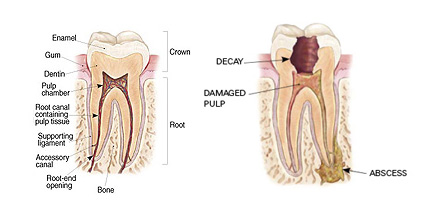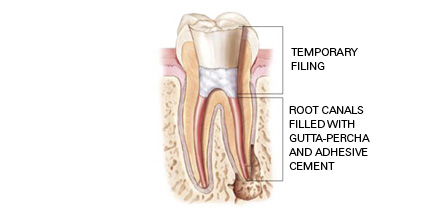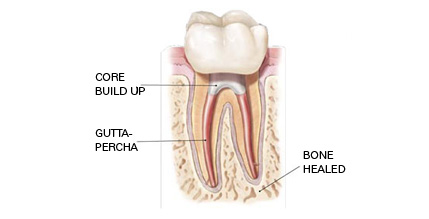Each year, about one million root canal treatments are performed in Canada. It is a common dental procedure with a documented success rate of over 90%. The word endodontic literally means 'within the tooth'.
endo -within | dontic -toothThus, endodontic treatment involves removal of soft tissue (pulp) from a tooth. Pulp is the soft tissue inside a tooth; it occupies the canal space in the centre of a root and the chamber space in the centre of the crown. It consists of blood vessels, nerves, connective tissue, and lymph vessels.

Injury and infection of the pulp is caused by trauma, deep cavities, new fillings or crowns, cracks, and chips. Signs of an injured or infected pulp may include the following:
- Sensitivity to hot, cold, bite, chewing, touch, or sweets
- Spontaneous pain
- Constant pain
- Swollen gums, roof of mouth, floor of mouth, cheek, lip, eyelid, face, or neck
- A bad taste in the mouth
If you experience any of these signs or symptoms a dental examination is necessary. If the pulp is injured or infected, root canal treatment will be necessary.
Endodontic treatment is typically completed in one or two appointments. Local anaesthetic (freezing) ensures no pain is felt during treatment. Once adequately frozen the tooth is isolated under a protective sheet (rubber dam). An access opening is made in the crown of the tooth, exposing the pulp chamber. This allows the removal of the pulp from the chamber and canal(s).

The beginning of endodontic treatment
Endodontic instruments (i.e. files) are used to both 'shape' the walls of a canal as well as remove the pulp, bacteria, and débris. Irrigation involves various medications and solutions being introduced to further rid the canal of pulp, débris, and bacteria. Together shaping and irrigating both cleanse the canal and prepare it for sealing (a.k.a. obturation). The prepared canal is then filled and sealed with biocompatible materials, making it an inhospitable environment for bacteria. A temporary filling is placed in the access opening in the tooth to provide a protective seal.

Endodontic treatment completed
Within one to two weeks after a root canal treatment is completed, the temporary filling must be replaced with a permanent filling (core build-up). This provides a long-term seal, preventing bacteria from recontaminating the treated canal(s). A crown is often recommended to 'envelope' the tooth, protecting it from fracture and providing the ultimate seal against bacteria recontamination.

Endodontically treated tooth with a crown
Removal of the pulp does not render a tooth dead. It is still alive as its periodontal ligament is healthy. This ligament is nourished by the surrounding tissues and is responsible for holding the tooth in the jaw.
Endodontic treatment allows a tooth to function normally and retain its natural aesthetics; it saves teeth from being extractedIn terms of health, investment, and conservative treatment there is no substitute for retaining a tooth. Even the most advanced bridge or implant cannot truly replace a natural tooth for function or aesthetics. Endodontic treatment and restoration of a natural tooth is most often more cost-effective than alternative treatment options. If your dentist recommends a tooth for extraction, ask if our endodontists can save the tooth with a root canal or microsurgical endodontic procedure.
Next Section | Pain Free →








